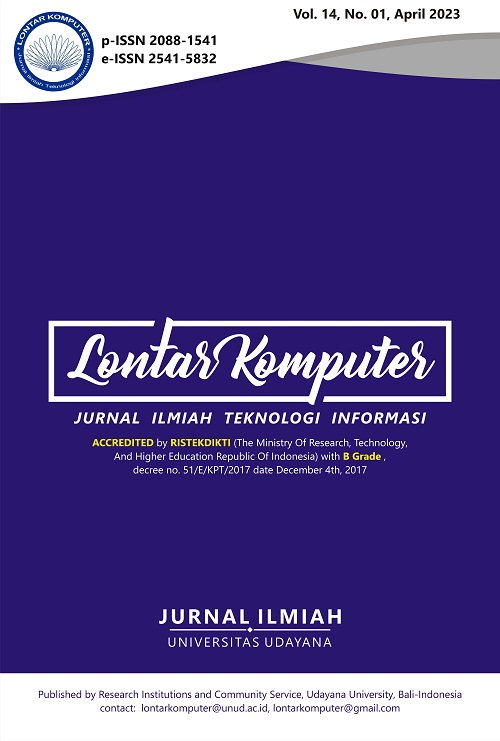Associative Classification with Classification Based Association (CBA) Algorithm on Transaction Data with Rshiny
Abstract
Data mining can be used for businesses with large amounts of data. One of the data mining techniques is Associative Classification. It is a new strategy in data processing that combines association and classification techniques to build a classification model. This research used an associative classification technique on sales transaction data of Frozen Food Stores, which had sales transaction data on their business activities. It would be used in sales strategies to find items often purchased by class customers, namely, members and general. This research aimed to classify based on association rules using the CBA (Classification based Association) algorithm on sales transaction data. The application used the R programming language that business owners could use. The results of the rules obtained from the trial had the value of support, confidence, coverage, and lift ratio, which were the best value levels of a rule. The results of the rules that had the highest lift ratio value from all the data that have been inputted can be used as a reference to be implemented in sales strategies in knowing consumer needs.
Downloads
References
[2] A. Erfina, M. Melawati, and N. Destria Arianti, “Penerapan Metode Data Mining Terhadap Data Transaksi Penjualan Menggunakan Algoritma Apriori (Studi Kasus : Toko Fasentro Fancy),” Jurnal Ilmiah Sains dan Teknologi(SANTIKA), vol. 10, no. 1, pp. 11–17, 2020.
[3] F. R. Pare, O. Wati, L. P. Taran, and L. M. Arsai, “Penerapan Data Mining Pada Transaksi Penjualan Barang Menggunakan Metode Apriori (Studi Kasus:Toko BE-MART),” Jurnal Teknologi Terapan G-Tech, vol. 7, no. 1, pp. 255–261, 2023.
[4] A. Maulana and A. A. Fajrin, “Penerapan Data Mining Untuk Analisis Pola Pembelian Konsumen Dengan Algoritma Fp-Growth Pada Data Transaksi Penjualan Spare Part Motor,” Klik - Kumpulan Jurnal Ilmu Komputer, vol. 5, no. 1, p. 27, 2018.
[5] P. N. Harahap and S. Sulindawaty, “Implementasi Data Mining Dalam Memprediksi Transaksi Penjualan Menggunakan Algoritma Apriori (Studi Kasus PT.Arma Anugerah Abadi Cabang Sei Rampah),” Matics, vol. 11, no. 2, p. 46, 2020.
[6] Siregar Simon Sadok and Friska Abadi, “Penerapan Frozen Food Technology Di Ukm Mimingfish Untuk Meningkatkan Diversifikasi Produksi Dan Ekonomi,” Pro Sejahtera, pp. 2656–5021, 2021.
[7] K. D. Rajab, "New Associative Classification Method Based on Rule Pruning for Classification of Datasets," IEEE Access, vol. 7, pp. 157783–157795, 2019.
[8] A. F. Andikos and H. Andri, “Pengujian Association Clasification Dalam Meningkatkan Kualitas Minyak Sawit Sebagai Bahan Dasar Biodisel,” Jurnal Media Informatika Budidarma, vol. 3, no. 4, p. 340, 2019.
[9] H. F. Ong, C. Y. M. Neoh, V. K. Vijayaraj, and Y. X. Low, "Information-Based Rule Ranking for Associative Classification," 2022 International Symposium on Intelligent Signal Processing and Communication Systems (ISPACS), 2022.
[10] C. Thanajiranthorn and P. Songram, "Efficient rule generation for associative classification," Algorithms, vol. 13, no. 11, 2020.
[11] P. U. Gio and A. R. Effendie, Belajar Bahasa Pemrograman R, vol. 1, no. 1. 2017.
[12] I. P. A. P. Wibawa, I. K. A. Purnawan, D. P. S. Putri, and N. K. D. Rusjayanthi, “Prediksi Partisipasi Pemilih dalam Pemilu Presiden 2014 dengan Metode Support Vector Machine,” Jurnal Ilmiah Merpati (Menara Penelitian Akademika Teknologi Informasi), p. 182, 2019.
[13] M. Hahsler, I. Johnson, T. Kliegr, and J. Kuchar, "Associative classification in R: Arc, arulesCBA, and rCBA," The R Journal, vol. 11, no. 2, pp. 254–267, 2019.
[14] N. Abdelhamid and F. Thabtah, "Associative Classification Approaches: Review and Comparison," Journal of Information & Knowledge Management, vol. 13, no. 3, 2014.
[15] W. Cao, Q. Zhong, H. Li, and S. Liang, "A Novel Approach for Associative Classification Based on Information Entropy of Frequent Attribute Set," IEEE Access, vol. 8, pp. 140181–140193, 2020.
[16] D. Sasirekha and A. Punitha, "A comprehensive analysis on associative classification in medical datasets," Indian Journal of Science and Technology, vol. 8, no. 33, 2015.
[17] M. Abrar, A. T. H. Sim, and S. Abbas, "Associative classification using automata with structure based merging," International Journal of Advanced Computer Science and Applications(IJACSA), vol. 10, no. 7, pp. 672–685, 2019.
[18] F. Padillo, J. M. Luna, and S. Ventura, "Evaluating associative classification algorithms for Big Data," Big Data Analytics, vol. 4, no. 1, 2019.
[19] L. Venturini, E. Baralis, and P. Garza, "Scaling associative classification for very large datasets," Journal of Big Data, vol. 4, no. 1, 2017.
[20] F. Jiří and T. Kliegr, "Classification based on associations (CBA) - A performance analysis," CEUR Workshop Proceedings, vol. 2204, 2018.

This work is licensed under a Creative Commons Attribution 4.0 International License.
The Authors submitting a manuscript do so on the understanding that if accepted for publication, the copyright of the article shall be assigned to Jurnal Lontar Komputer as the publisher of the journal. Copyright encompasses exclusive rights to reproduce and deliver the article in all forms and media, as well as translations. The reproduction of any part of this journal (printed or online) will be allowed only with written permission from Jurnal Lontar Komputer. The Editorial Board of Jurnal Lontar Komputer makes every effort to ensure that no wrong or misleading data, opinions, or statements be published in the journal.
 This work is licensed under a Creative Commons Attribution 4.0 International License.
This work is licensed under a Creative Commons Attribution 4.0 International License.























